Guest Post by Heather Hohlowski
Why the *$@# Do They Call it A Sport?
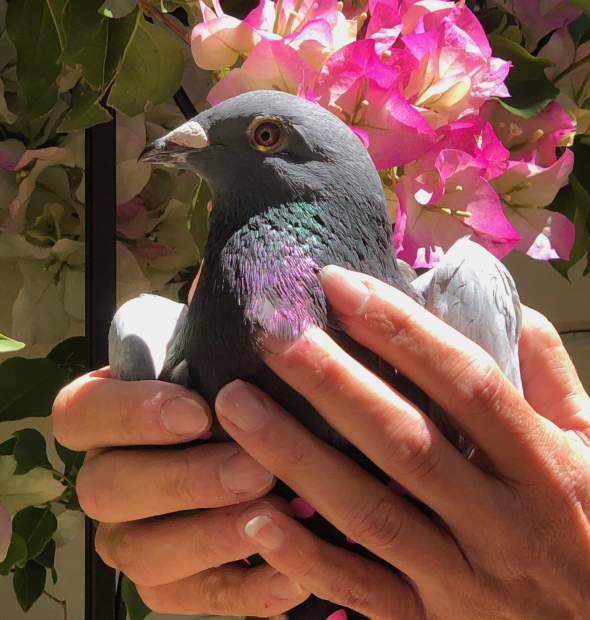
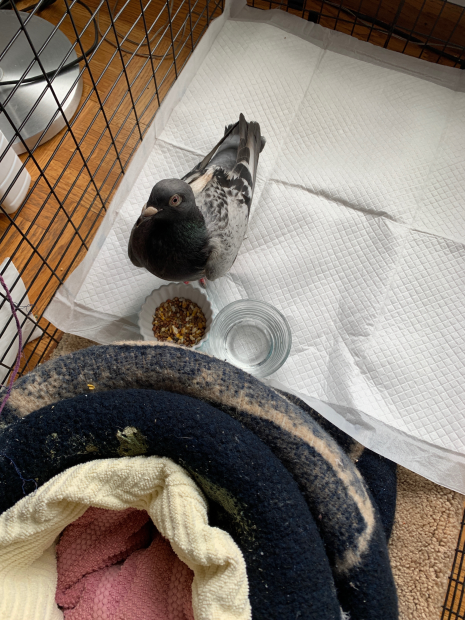
The so-called “sport” of pigeon racing began more than 200 years ago, in Belgium. The racing breed of pigeons is selectively crossbred and trained, with the goal being a bird that gets back to its often very-far-away destination as fast as possible. Like greyhound racing, horse racing and the like, a select group of human beings enjoy training other species to run or fly ridiculous distances at top speed as a “sport” that they can enjoy. The animals are toys for them. By any rational definition, a sport is one that the participants consent to. But these pigeons, like the greyhounds and horses, have never agreed to participate in these races; they are forced to.
And here are some statistics from these races. In June 2021, roughly 25,000 homing pigeons (out of 250,000 who raced in 50 events throughout England) disappeared (i.e., suffered horrible, painful deaths). Instead of blaming themselves for selectively breeding birds that cannot survive the elements or being lost, breeders blamed these staggering losses of life on the weather: a meteorological event that may have altered the Earth’s magnetic field.1 They then went on to just breed lots more birds for their next race.
The so-called “Olympics of pigeon racing” is the annual South African Million Dollar Pigeon Race (SAMDPR). The non-consenting contestants often die — some from viruses caught while held in quarantine in South Africa with other pigeons from all over the world, others from exhaustion, predator attacks, dehydration, and starvation. On average, according to an investigation by PETA in 2020, the survival rate for SAMDPR racers is 22%; more than three-fourths of the birds die.2 When PETA launched a petition to convince Queen Elizabeth II to end royal participation in the “sport”, an organizer of the event said: “The pigeons have no jockey on their back to force them to fly. They do this of their own free will and love of the loft.” 3
True—there exist no pigeon-sized humans dressed in checkered pants riding the pigeons with a crop. But to say the birds have a choice about racing—as though they could tell their owners they want to opt out—is absurd in the extreme. They are not racing. They are flying their hearts out to get back home. Additionally, this response completely ignores the very relevant fact that racing pigeons are specifically bred by humans to fly in these inhumane races—and nothing else. They are not bred to survive outside the loft as that is not a skill the breeders have any interest in. These pigeons have no survival skills in the wild. As Palomacy founder Elizabeth Young puts it, “There is no place in the wild skies for domestic birds.”
It can be challenging for some to comprehend cruelty on this massive a scale and so it can help to zoom in and take a look at the impact of racing on a specific, individual bird. Allow me to introduce Pidgy.
A Good Samaritan & A Stroke of Good Fortune
Palomacy was first alerted to Pidgy’s plight by Good Samaritan Nazgol on March 30, 2020, via email:
“I found an injured pigeon a few days ago and no one wants to take responsibility of it. I’m tired of calling around. The wound is better but poor bird is paralyzed in almost both legs. I just need guidance to how take care of this bird that can fly back to wild.”
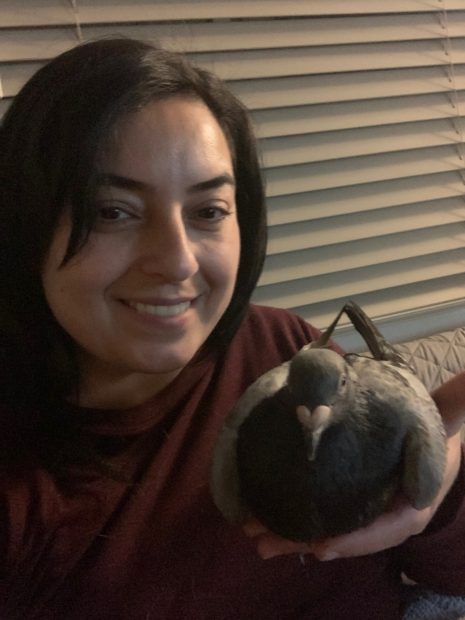
Nazgol stopped traffic to save Pidgy
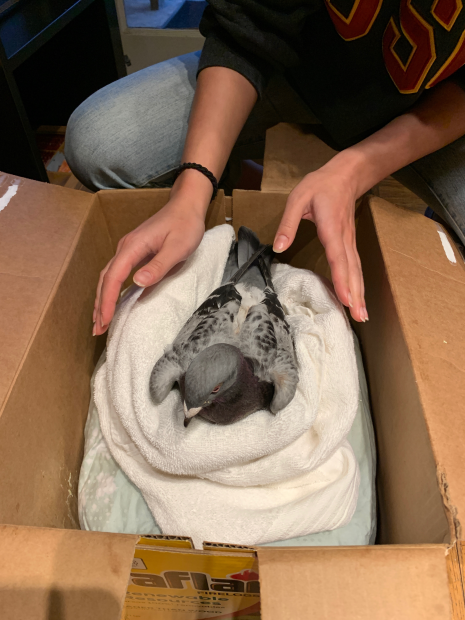
Nazgol had seen the bird hit by a hawk and then fall from the sky on to a busy road.
Within a few hours, Elizabeth emailed back:
“Hello, thank you for helping this poor pigeon. So sorry you’re having trouble finding assistance. The paralyzed legs are often a symptom of an impact injury/spinal trauma & pigeons can often recover with supportive care & time. Where are you located? Can you please send me a photo or two of the pigeon so that I can best advise?”
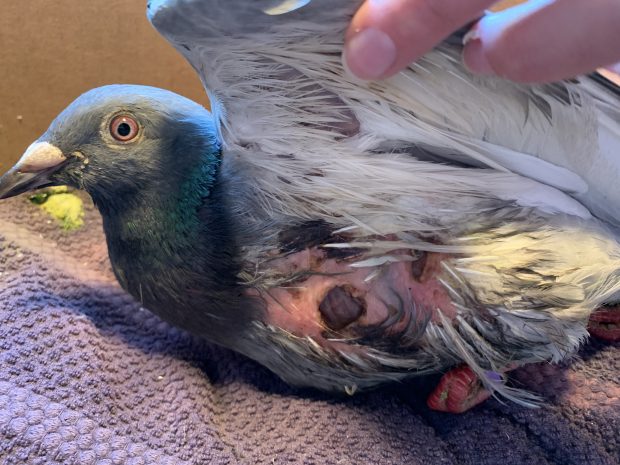
Wounded by the hawk strike
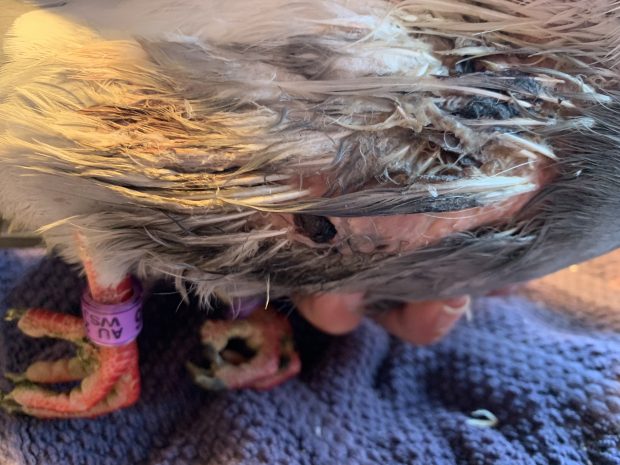
Nazgol had been nursing Pidgy’s wounds as best as she could and was grateful an organization like Palomacy existed to help these birds, whose owners do not accept responsibility for the pain and suffering that results from their “sport”. When you find a pigeon with a leg band and reach out to the owner based on the band’s information, the most common response is, “just kill it.” A racing bird who can’t race is worth exactly $0 to a breeder; the bird’s suffering does not factor into any equation in his mind.
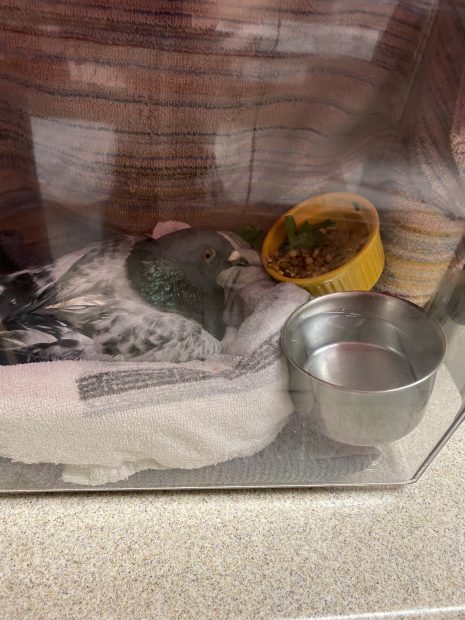
Hospitalized at Medical Center for Birds
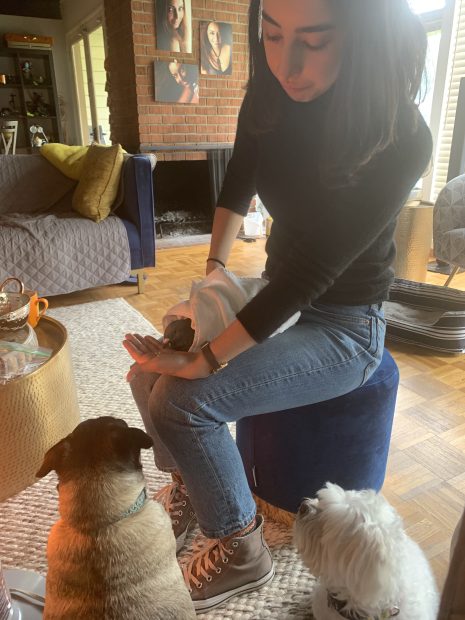
Nazgol helped Pidgy through every stage of his recovery
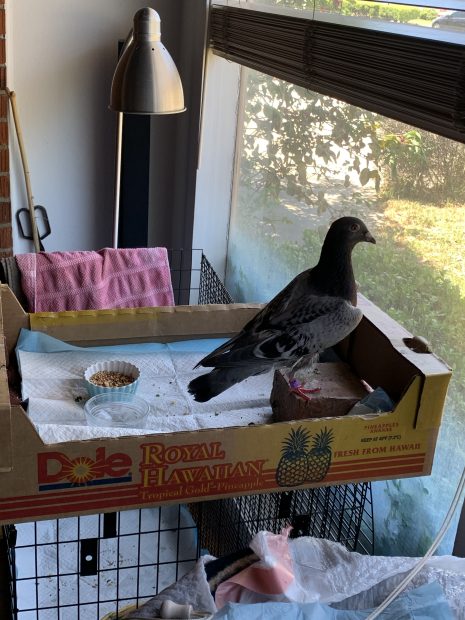
He fully recovered except for use of his joint-shattered leg
After avian vet care from Medical Center for Birds in Oakley, California, and weeks of recovery fostered with Nazgol, Pidgy slowly recovered from his spinal trauma and then faced recovery from the surgery that reconstructed his ruined leg. He was fostered by Elizabeth in her aviary, where he met and won the heart of Carmel, a Tippler pigeon.
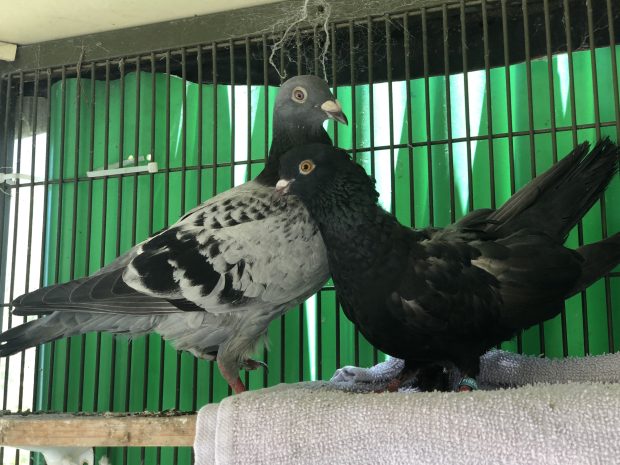
Pidgy & Carmel married
They both eventually came to me, and currently live in my backyard aviary.
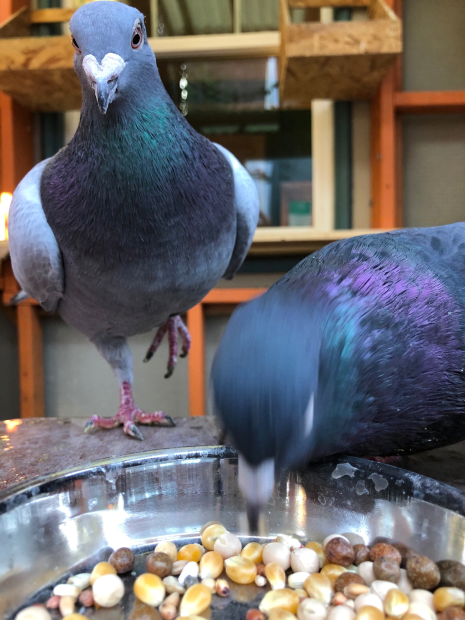
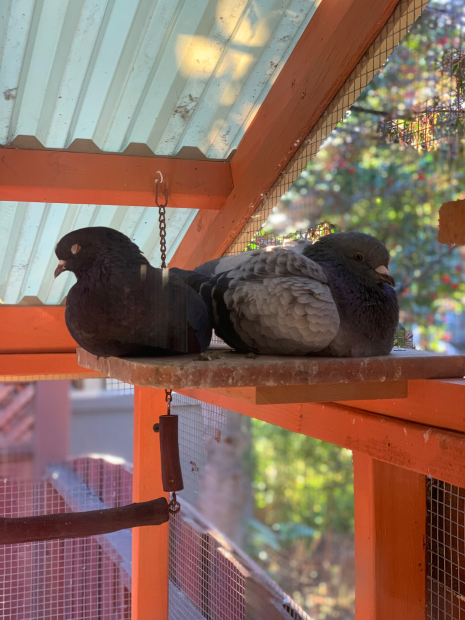
Carmel & Pidgy enjoying an afternoon nap
A Strange Lump
One day in April, I noticed a bump on what appeared to be Pidgy’s shoulder. My first thought was a feather cyst. It was white and a little bigger than a pencil eraser. Then two weeks ago, the bump was suddenly a significant protuberance. I sent pictures to Elizabeth and when she came over and took a look it became clear that this was the top of a pin put in during the 2020 surgery. Pidgy had never regained function of his left leg—it kind of dangles, slightly bent—so he hops around the ground and either stands on right leg or loafs when at rest. Somehow the pin had now suddenly shown itself. Elizabeth got an appointment at MCFB for the next day and on my way to Oakley for the visit, I was struck by Pidgy’s stoicism.
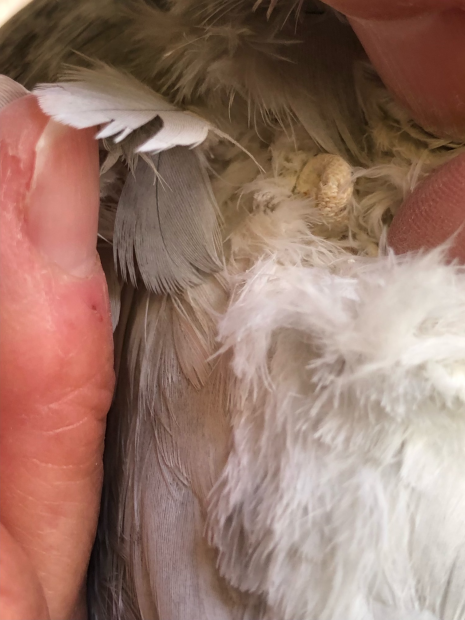
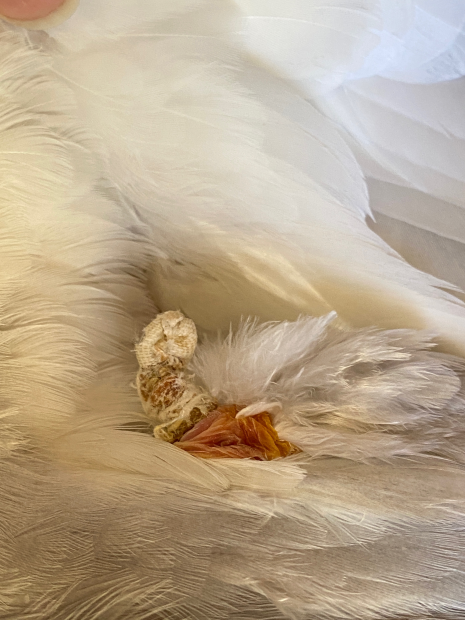
Pigeons are very good at hiding their pain.
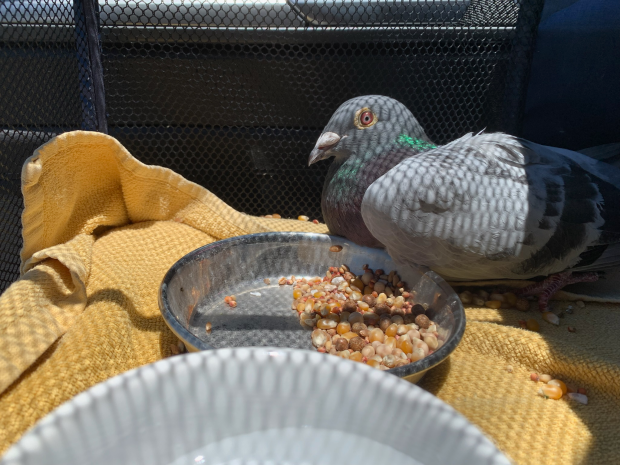
Pidgy calmly rides to the vet
I tried to drive at a very steady speed—avoiding sudden braking or fast turns—because each time the car lurched or halted, Pidgy tipped, used his wings to right himself, and hopped around the carrier trying to reestablish some balance. At one point he fell and flipped over the small food dish I had put in there for him. Seeds scattered and Pidgy simply readjusted. He vomited several times (pigeons do get car sick, just like people). But he never made a sound. He just continued to take all the excruciating curveballs life threw at him.
At stops in traffic, I looked at him. I looked into his eyes seeking information—was he mad at me? Did he blame me for this uncomfortable ride? Maybe. I think I would if I were him. I reached into his carrier when I could and I rubbed his head and told him we would be there soon and he would feel better. He looked back at me with a steady gaze, with what felt like forbearance. He seemed so calm, patiently waiting to see: “What now?” What other options did he have?
Zero-Sum Pain
Why was life so unfair to Pidgy and to tens of thousands of birds like him? Unlike so many of life’s cruel vagaries—floods, drought, hurricanes—this was entirely avoidable. This wasn’t life being unfair. It wasn’t the weather being unfair. This was entirely a manmade cruelty. It was entirely a zero-sum game, where the money and “glory” breeders win is extracted in an equivalent sum of pain and suffering for the birds.
As I drove on, I compared and contrasted our experiences. I had a cool drink, an apple, and my favorite Pandora station. I knew where I was going, I knew when we would arrive, and when we’d get back home. I wasn’t scared. Pidgy was, at a minimum, in a considerable amount of discomfort. He had no idea of where we were going or what was awaiting him when we got there. I kept telling him it would be ok, but I couldn’t speak his language.
We got to the vet and it turned out to be a simple fix — Dr. Speer removed the pin and Pidgy and I were back on the road. Once again, Pidgy seemed to take the ride in stride, as I worried about his unvoiced discomfort.
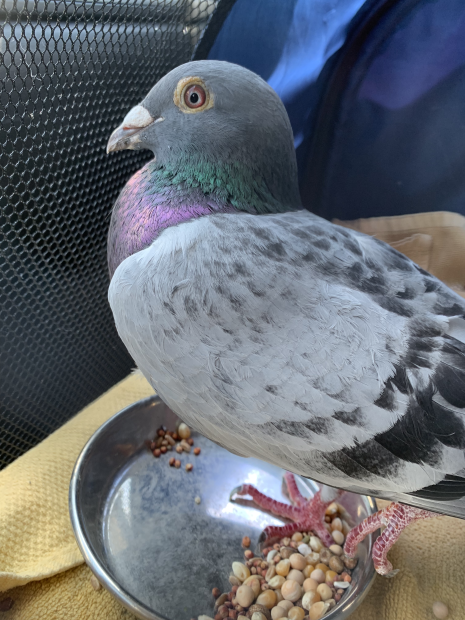
On the way back: I wonder what you are thinking Pidgy…
All I could do was drive steady, avoid sudden stops, and control the car’s temperature. It wasn’t enough, but it was the most I could do.
It was also the least I could do.
And I was sad that those two things were the same.
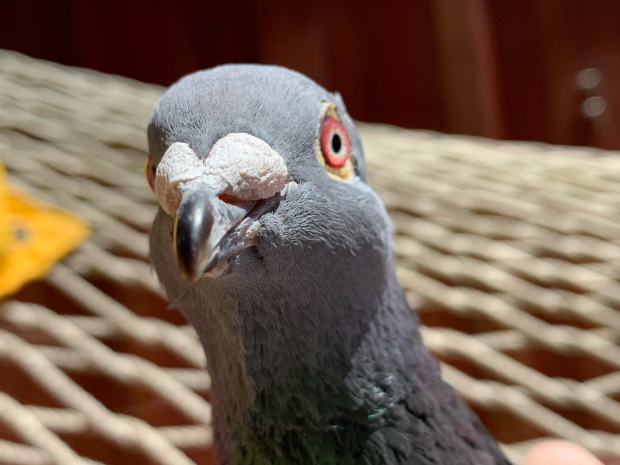
Footnotes
1 Hundreds of homing pigeons disappear in Wales on same day thousands vanish across UK (accessed 5/20/22)
2 Queen urged to ditch ‘cruel’ pigeon racing sport (accessed 5/20/22)
3 #nottheonion
Learn more about pigeon racing and read more raced pigeons’ stories here .
Read some of our other rescued racing pigeon stories:
Henry, In Memory
Lilo: Pigeon Racing Survivor
Self-Rescuing Raced Pigeon Survives Thanks to You
Barry’s Story
Freddie’s Story: An Almost-Survivor of Pigeon Racing
You Saved Summer
Blossom’s Ordeal
Pebbles: An Almost-Survivor of Pigeon Racing
Feather & Bone
Josie: An Almost-Survivor of Pigeon Racing
Woot: There He Is
Aurora: Healing the Broken
The Story of Mr. Bird
The Blue and the White
Elinor’s Story

